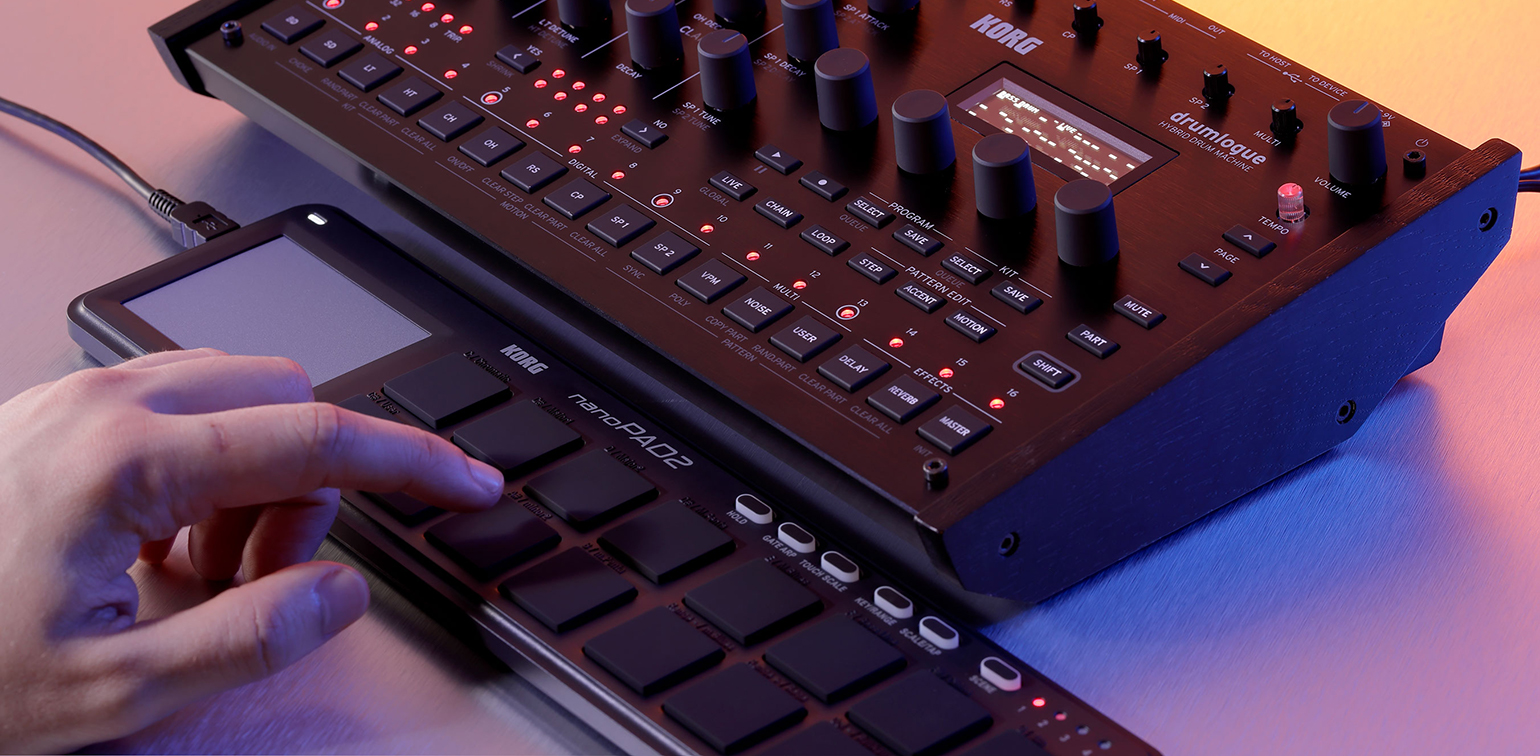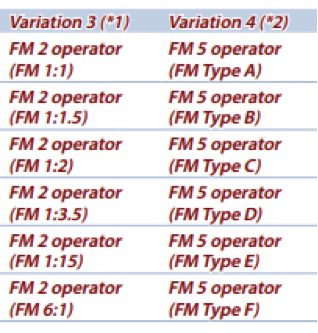FM Synthesis: Beyond the Basics
US 10 Wild instruments of FM chaos 14/06/24

|
Many synths feature FM somewhere in the title, and often - it's not your standard vanilla sine on sine Yamaha twang, but something far more exciting! Here's a brief overview of 10 weird and wild FM instruments that make very interesting sounds. We'll dig into some of these in more detail in future articles.
Note: If you are interested in experimenting with FM - Waves have given us Flow Motion FM Synth for free:
Details here: http://bit.ly/sonicflow24 (ends 24th June)
1. Evolution EVS 1
You can't even program it from the front panel! 1990's EVS1 was designed as a "my first synth module" for the Atari ST generation. You can edit sounds via an ST (or thank goodness, Windows - even Win10!) and what a bunch of sounds they are. The various algorithms include 4OP FM and PM (it's basically like a TX81z in this mode) but adds a bunch of unique modes like voice synthesis, waveshaping, width modulation and audio rate AM.

The envelopes feel pretty coarse and so the experience feels less smooth than on a Yamaha machine - sometimes you feel like the machine is barely keeping itself together, especially when you start to add multiple modulations to the mod matrix! But I feel that the unique tones are really worth the effort. For the odd happy accident, there are 32 single cycle waveforms on board, so you can switch out the sine for something a bit spicy!
Check out a demo here:
2. Korg Drumlogue: FM64

Oleg Burdaev, alias dukesrg, has ported Dexed to the Drumlogue in 4-voice poly. Currently LFO's and pitch envelopes aren't implemented - but there are a number of weird and wonderful things that this implementation does over other FM synths:
- Dexed patches are converted to a WAV file on his website, and then, once imported, are loaded in instantly to FM64(kind of like how old computers loaded games from tape, but faster?)
- You can't fully edit these patches, but you can make many meaningful tweaks - carrier and modulator volumes, envelope time macros, detune etc. You can also change the feedback routing and depth, choose a new algorithm (spin the wheel!) and automate all of these parameters with the Drumlogue sequencer.
- You can import your own waveforms(!) - and choose to use these for the carriers, modulators, or both. I started by adding some DWGS and MicroQ waves, but have since found a way of importing PCM samples!
It really is an FM synth like no other. Demo wise, please be patient as I'm currently working on a video on this topic. In the meantime, check out the manual here:
https://dukesrg.github.io/logue-osc/FM64%20Operations%20Manual.pdf
3. Korg OPSIX
Korg OPSIX brings all sorts of weirdness to the table. A selection of operator waveforms, insert effects that can be placed in between operators(!), filter FM and tonnes of modulation possibilities. Check out our Sonic LAB review here:
4. Korg Kronos/Nautilus: MOD7
MOD7 is kind of getting on now. Initially released for Korg's OASYS platform, this flexible engine can still surprise and delight. You can use PCM samples as operators, which takes some finesse (it's easy to make white noise this way!) but two filters can be placed in between the operators if needed - to mute some high frequency content, (filtered samples generally make great FM modulators, a source of warbly, eccentric tones!) and in addition, there's ring modulation, plus waveshaping tables from Korg's classic 01/W line. Honestly, it's an endless playground of inspiring FM tones.
5. Nord Modular G1
I love my G1! There's an archive somewhere of converted DX7 patches for this little red synth that could. I find that there's a lot fun to be had, however, by putting bitcrushers or other modules in between the FM operators and then using the knobs to control their intensity. Using a sequencer (clocked at audio rates) as a crude digital operator also leads to some rather delightful tones that sound like they're from the very dawn of digital synthesis! This is before you realise that you can step sequence every parameter and create total rhythmic chaos!
Nord Live-stream here: https://www.youtube.com/live/KzimpLWwVHU
6. RYK Vector Wave
The Vector Wave offers 4 operator FM, but each of those operators can be easily set to a meaningful harmonic. You have 4 of these 4OP voices, meaning that you can play polyphonically or stack them - a massive monophonic 16OP voice where operators can be mixed in and out using the onboard vector joystick. Waveshaping, modulation possibilities and the aforementioned vector control complete a compelling package. Check out our Sonic Lab review here:
7. Roland System 8
The System 8 always had Crossmod (exponential FM or AM depending on the model loaded), FM and FM+Sync. But v1.20 added a bunch of new FM oscillators - these are clusters of operators with controls (the "color" knob) mapped to FM depth. I was impressed by the choice and variety of operators and enjoyed being able to quickly make very nice FM bells and pads.

Here's the thing though, your FM patch can then be modulated FURTHER! You can either modulate the FM depth with a suboscillator, which sounds pretty chaotic (there's a bug and every 8th note sounds wrong, but it's fine in mono mode) AND/OR apply the nasty exponential Crossmod to the entire FM patch if you'd like.
I demonstrate this wild Crossmod on an FM bass sound at the start of this video, enjoy!
8. Waldorf Blofeld/Microwave XT

Waldorf's orange beast - and it's diminuitive Bond-villain cousin, both offer 2OP FM between their wavetables. Modulating said wavetables over time therefore gives you a lot of flexibility, it's almost like having more operators! Blofeld actually goes a little further in this department as you can use PCM samples to FM other oscillators or the filter! Using a string sample to modulate Filter FM is one of the coolest pad sounds I've ever heard! I will have to do a demo on this some time.
9. Yamaha EX7
The Yamaha EX7 has an algorithm called self-FM where any waveform, basic or sampled, can be FM'd by itself - with an optional lowpass in between if desired. It's a great way of quickly getting unique sounding 2OP patches and, because you can map phase control to a wheel, you can play them pretty expressively!
Read more details here: https://sonicstate.com/news/2024/02/02/yamahas-experimental-phase/
10. Yamaha SY77
Ah, the SY/TG77. It's so much synth for 1989 and capable of some truly stunning sounds. You get 6 operators, the ability to pipe in a PCM tone as another operator, 0Hz operators (to act as waveshapers), a looping amp envelope that can go audio rate(!), gorgeous flexible filters and some pretty nice old-school effects.
Check out an expansive audio demo I did, utilising many of these techniques: https://www.mediafire.com/file/okurcfg1o2ab81e/SYTG77_Demo_Paul_Alexander_Bow.mp3/file
There's so many delightfully weird FM synths - I could have kept going! I didn't mention any of Kurzweil's instruments for instance! Please let us know your favourite FM instrument, and also what techniques or information you'd like us to cover in this series of articles. Thanks!
Posted by MagicalSynthAdventure an expert in synthesis technology from last Century and Amiga enthusiast.
< More News: Like This
- Le Grand Strum - Melodic MIDI Instrument 20-Jun-24
- The Acoustics inside the Great Pyramid 20-Jun-24
- Anemond presents Sloom - Extreme Timestretcher 20-Jun-24
- Y-17: Synthesizer Meets Ferrofluid Visualizer 19-Jun-24
- Essentials: 5 Free Max4Live Devices 19-Jun-24
Even more news...






